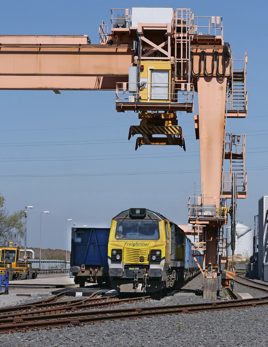The glittering prizes
Various studies have calculated that about a third of HGV tonne mileage is very realistically transferrable to rail - about 200 million tonnes a year and roughly a trebling of today’s figure.
“For most main lines, that would represent one or two extra freights an hour in each direction over an 18-hour day, which shouldn’t scare the horses,” argues Julian Worth.
“The two exceptions are the WCML and Felixstowe-Nuneaton, which would see three or four extra trains an hour. But a well-defined set of enhancements - sorting out Ely, doubling Soham and some of the Felixstowe branch, with four tracks through Leicester - could deliver another 60 trains a day for Felixstowe boxes and some aggregates.”
It is to be hoped that the Treasury will recognise the scope for easy and quick progress in carbon reduction through intelligently targeted investments to allow rail freight to grow.
Worth suggests that the value of carbon used in appraisals should be increased to the $75 (£55) a tonne recommended by the International Monetary Fund - more than three times higher than currently used in the UK. Compared with the complexities and costs of carbon reduction through domestic heating changes, rail freight offers an abundance of low-hanging fruit at relatively modest cost.
Work is under way to create a strategic freight unit within GBR. For its success, Guy Bates sees the “need for more engagement with a broader range of stakeholders, looking to identify the market that doesn’t use rail but has the volume and interest to use it”.
He adds: “The unit needs to be engaged with the Sub-National Transport Bodies, which have a real appetite for modal shift and potentially have access to funding. They cover large areas of the country, and National Highways involvement would allow both road and rail to look at ways to make the best use of our networks in a co-ordinated manner.
“The challenge for GBR’s strategic freight unit will be how to bring parties to rail that currently aren’t. It could be existing traffics from quarries that currently have no rail connection or enabling rail to serve principal manufacturing centres.”
The Britishvolt battery gigaplant being built on a 135-hectare site at Port Blyth will be the fourth largest building in the UK, and Isobel Sheldon, chief strategy officer at Britishvolt, has cited the site’s rail link as a reason for the choice of location: “There’s an existing rail line in place, which previously had a branch into the power station when it was operational. This has been closed but can be reinstated, so products can be transported by rail.”
Guy Bates points to the fact that only 20% to 25% of our intermodal traffic is domestic, where rail has supplanted road for trunk haul movements feeding retail and supermarkets.
“We don’t have the disposition of intermodal interchanges we need. With a suitable commercial model - and we aren’t looking at colossal sums - we would be in a position to urgently progress a number of interchange schemes around the country to deliver modal shift more quickly.
“The prime areas are the South West, Lincolnshire and south of the Thames. Some will require participation of third parties. We know the traffic is there and we want to see those realised to create a market that corresponds to an ambitious target to grow rail freight. The impact on carbon reduction within national surface transport would be transformative.”












